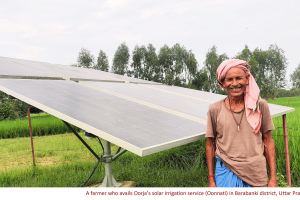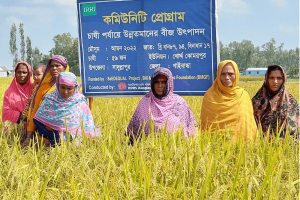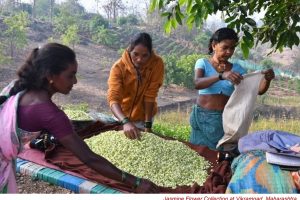
An integrated and participatory extension approaches is very critical in improving goat productivity through supplementary feeding during transition period. Dr Prakashkumar Rathod, Dr Veeranna K C, Dr Ramachandra B and Dr Ravindra D share their experiences of supplementary feeding of goats during transition period for improving productivity under Sujala-III project implementation in Karnataka (India).
CONTEXT
Goats, whose meat (chevon) is one of the choicest meats, are among the main meat-producing animals in India and have huge domestic demand. Besides meat, goats provide other products like milk, skin, fibre and manure. With a population of over 135 million, goats account for more than 9,43,000 tonnes (13%) of the total meat production in India (GoI, 2017).They provide food and nutritional security to millions of marginal and small farmers and agricultural labourers. However, the productivity of goats under the prevailing traditional production system is very low (Singh and Kumar, 2007) since they are maintained under the extensive system on natural vegetation on degraded common grazing lands and tree lopping. Moreover, adoption of improved production technologies/management practices in the farmers’ flock is very low (Tekale et al., 2013). Therefore, rearing of goats requires adoption of scientific technologies or practices for improving the production and also to meet the increasing demand in the domestic as well as international markets.
In this context, various attempts are made to introduce scientific and superior technologies for mass adoption and create necessary facilities for adoption of improved management practices in goat keeping. Further, implementation of any improved scientific practices and its adoption in practical field conditions depends on various factors and adoption behaviour of the individuals. Among various issues, supplementary feeding of goats during transition period is the major drive for improving the productivity through reproductive performance of goats. It helps in improving the kidding rate, weaning rate, kidding interval, live weight of kids born or weaned, milk yield of does (goat mother), health status of doe and kids etc.
Box 1.Supplementary Feeding of Goats during Transition Period
With the time between weaning and mating, ewes should nutritionally replenish losses from the previous kidding. It is advisable to increase level of nutrition before and after mating, resulting in higher ovulation and conception rates, and to make provision for the additional nutritional needs in late pregnancy and early lactation. The transition period is considered by many nutritionists and academicians as the time period of late pregnancy to very early lactation. It is often a varying period, which depends on the species of livestock. However, the authors have followed 60 days pre-kidding to 30 days post-kidding period. Over this very short period, the animal is forced to deal with radical changes such as: difficulties of gestation, parturition, onset of lactation, appetite fluctuations (from a gestation diet to a lactation diet), and fluctuations in hormone levels. The critical points to remember are nutrient compositions and feed formulation of supplementary feed (concentrate mixture) used for feeding. Approximately the concentrate mixture consists of 15% crude protein (CP) and 65% total digestible nutrients (TDN) as per book values which can be prepared using the ingredients like maize (30 %), groundnut cake (5 %), soya bean (5 %), green gram chuni (10 %), rice polish (5 %), wheat bran (40 %), limestone (2 %), mineral mixture (1%) and salt (2 %). The supplementary feeding composition can be varied depending on the availability of inputs and socio-economic status of the farmers at field conditions.
Considering the vitality of above stated facts, we therefore emphasised supplementary feeding of goats during transition period for improving productivity and focused on adoption and diffusion of scientific practices for the benefit of other farmers in the project villages. Further, this project has also addressed the constraints faced by the project staff and farmers in this activity.
THE INITIATIVE

The good practices discussed in this note are from the project villages of the World Bank-funded, Karnataka Watershed Development Department (KWDP)-sponsored Sujala-III project. This project has been implemented by Veterinary College, Bidar, which is under the aegis of the Karnataka Veterinary, Animal and Fisheries Sciences University (KVAFSU), Bidar (Karnataka), from December 2014. However, this particular activity was undertaken during the year 2016-17. The development objectives of Sujala-III project are to demonstrate more effective watershed management through greater integration of programmes related to rainfed agriculture, innovative and science-based approaches, and to strengthen institutions and their capacities with the involvement of individual farmers and member farmers of producer organisations (for example: Karnataka Milk federation, private milk societies etc.). We undertook a study on this initiative mainly to understand the process and impact of this initiative (Box 2).
Box 2. Methodology of the study
- Purposive sampling technique was used for selecting Bidar district since Sujala-III project was implemented in this district by Veterinary College, Bidar.
- A baseline survey was conducted of about 790 farmers from 14 project villages identified by the Government of Karnataka (India) and various meetings/awareness programmes in the project villages. Further, about 220 goat-rearing households were contacted for this activity, out of which a total of 96 pregnant does were selected for this study.
- Awareness programmes, trainings and demonstrations about supplementary feeding of pregnant goats (does) and its importance were conducted by multi-disciplinary teams for the beneficiaries. A beforeafter research design was followed with participatory research to know the impact of these programmes in the project villages.
- Pre-exposure and post-exposure attitude tests, knowledge tests and adoption studies were conducted in the project villages, focusing on the objectives of the scheme, before and after conducting the awareness and demonstration programme.
GOOD PRACTICES
Awareness programmes, advisory services and demonstrations:
Multi-disciplinary teams conducted awareness programmes and trainings on scientific goat farming, supplementary feeding of goats during transition period and its benefits for the beneficiaries. The experts also conducted demonstrations for the farmers about preparation of supplementary feeds at field conditions. Further, the beneficiaries also participated in focus group discussions about different practices and issues under the guidance of experts or project staff. The project involved technical staff for creating awareness about the project activities, supplementary feeding and its importance. Timely advisory services by the technical staff helped the beneficiaries know the scientific practices and improve their knowledge to a great extent.
Access to inputs: Inputs such as supplementary feeds, dewormers and vaccines were distributed to the beneficiaries on a timely basis. The project beneficiaries identified for this practice received a 250-g feed packet prepared at the feed processing unit of Veterinary College, Bidar, for each doe per day. With this rate, the beneficiaries received the feeds as per the available does in their flock. Further, the project team also trained the farmers for preparation of supplementary feeds with the available resources at field conditions.





Add Comment